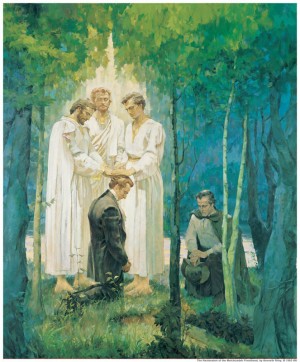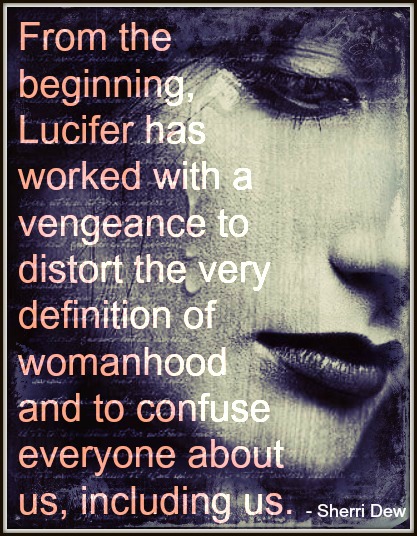The semi-annual General Conference of The Church of Jesus Christ of Latter-day Saints (sometimes inadvertently called the Mormon Church) is a worldwide meeting for all members. Included in the schedule is one session for men and one for women. Each highlights the separate and distinct roles that men and women have in the gospel of Jesus Christ, in their families and in the world. The session for the men is called the Priesthood Session, as it is for boys and men ages 12 and older who are eligible to receive the priesthood (which is the power that God gives to man to act in all things for the salvation of His children). Some have questioned why there are separate meetings for men and women, and why women aren’t ordained to the priesthood. Men and women have divine, distinct and complementary roles in God’s plan for his children. As we come to know and understand God’s plan for His children, we can see that all are eligible for and entitled to the blessings provided by the power of the priesthood. Elder Neil L. Andersen, a member of the Quorum of the Twelve Apostles (with the First Presidency, the governing body of The Church of Jesus Christ), said:
We sometimes overly associate the power of the priesthood with men in the Church. The priesthood is the power and authority of God given for the salvation and blessing of all—men, women, and children.
A man may open the drapes so the warm sunlight comes into the room, but the man does not own the sun or the light or the warmth it brings. The blessings of the priesthood are infinitely greater than the one who is asked to administer the gift. [1]
What is the Priesthood?
Answering the question of why only men are ordained to the priesthood must begin with a definition and history of the priesthood. The priesthood is the power and authority of God on the earth. President Boyd K. Packer, an Apostle of Jesus Christ, explained:
Priesthood is the authority and the power which God has granted to men on earth to act for Him. When priesthood authority is exercised properly, priesthood bearers do what He would do if He were present. [2]
The priesthood of God has existed from before the creation of the world. Elder Robert D. Hales, an Apostle of Jesus Christ, said:
The priesthood of God is timeless. … The formation of the universe and of the world upon which we live was brought to pass—not by chance, but through the power of the priesthood. … The processes of nature that enable us to exist on this planet, the resources of this world that sustain life—all were set into motion and continue their course through the power of God’s magnificent priesthood. While most of the earth’s inhabitants do not recognize this priesthood power, all living creatures are its beneficiaries. …
It was through the priesthood that the Son of God, the Savior, Jesus Christ, established his church. … Jesus Christ atoned for the sins of all who will repent and be baptized through the power of the holy priesthood. Through the Atonement, our Savior broke the bands of death and became “the author of eternal salvation unto all them that obey him” (Hebrews 5:9). [3]
The ordinances and covenants of the gospel of Jesus Christ are administered through the power of the priesthood. When He established His Church on the earth, He ordained 12 Apostles to carry on His work after He died. But that did not last. Elder M. Russell Ballard, an Apostle of Jesus Christ, explained:
Early Christians endured the challenges of persecution and hardship. Peter and his brethren had a difficult time holding the Church together and keeping the doctrine pure. … Eventually, with the known exception of John the Beloved, Peter and his fellow Apostles were martyred. The Apostle John and members of the Church struggled for survival in the face of horrifying oppression. To their everlasting credit, Christianity did survive and was truly a prominent force by the end of the second century A.D. Many valiant Saints were instrumental in helping Christianity to endure.
Despite the significance of the ministries of these Saints, they did not hold the same apostolic authority Peter and the other Apostles had received through ordination under the hands of the Lord Jesus Christ Himself. When that authority was lost, men began looking to other sources for doctrinal understanding. As a result, many plain and precious truths were lost. [4]
Thus, the power and authority of the priesthood were taken from the earth. Paul and other ancient prophets foretold of this. (See 2 Thessalonians 2:3 and 2 Timothy 4:3-4.) But Peter spoke of the “times of refreshing” and “the restitution of all things” (Acts 3:19-21)—which was that the gospel of Jesus Christ would be restored to the earth. The gospel of Jesus Christ was restored to the earth through Joseph Smith, who was the first prophet of God in the modern days. All of the principles and ordinances of the gospel that Jesus Christ instituted when He walked the earth—including His priesthood authority—were restored through the prophet Joseph Smith.
It’s essential to understand that the priesthood is God’s power and authority—thus God dictates the terms of its use. It is neither capricious nor biased that God gave men to the right to hold the priesthood. It is part of His grand design. From the time of Adam, as Elder Hales explained, the priesthood was passed “from father to son.” [3] Today, as often as permits, the priesthood is still passed from father to son in the same manner.
The Role of Women in the Priesthood
The priesthood is the same power that Jesus Christ used when He organized His Church anciently. When He called and ordained Apostles, Jesus Christ called a lay clergy—fishermen, publicans, etc. The Church of Jesus Christ in modern days is set up the same way. Because of the divine roles that Heavenly Father designed for His children, men are given the responsibility of carrying and bearing the priesthood. Women are given the responsibility of carrying and bearing children. Each is essential in God’s plan. Women are not ordained to the priesthood, but their role in the priesthood is just as important. President Packer said:
We are sometimes charged with being unkind to the sisters in that they do not hold the priesthood and therefore do not hold the offices that the brethren do. But it is well understood that whether or not we are exalted depends upon the sister who is at our side—the wife, the mother of our children—and no holder of the priesthood would in any way depreciate or mitigate the value and power of his wife. When I hear those comments that the sisters are less than the brethren, I wish that they could see inside the heart of every worthy holder of the priesthood and understand how he feels about his wife, the mother of his children—a reverence, not quite worship but a kind of worship, a respect for the companion in life that causes it to be that he can be exalted ultimately. [5]
In The Church of Jesus Christ, women have the important role of being wives and mothers, helpmeets for their husbands and teachers of their children. The Family: A Proclamation to the World states:
By divine design, fathers are to preside over their families in love and righteousness and are responsible to provide the necessities of life and protection for their families. Mothers are primarily responsible for the nurture of their children. In these sacred responsibilities, fathers and mothers are obligated to help one another as equal partners.
Elder D. Todd Christofferson said:
A woman’s moral influence is nowhere more powerfully felt or more beneficially employed than in the home. There is no better setting for rearing the rising generation than the traditional family, where a father and a mother work in harmony to provide for, teach, and nurture their children. Where this ideal does not exist, people strive to duplicate its benefits as best they can in their particular circumstances.
In all events, a mother can exert an influence unequaled by any other person in any other relationship. By the power of her example and teaching, her sons learn to respect womanhood and to incorporate discipline and high moral standards in their own lives. Her daughters learn to cultivate their own virtue and to stand up for what is right, again and again, however unpopular. A mother’s love and high expectations lead her children to act responsibly without excuses, to be serious about education and personal development, and to make ongoing contributions to the well-being of all around them. Elder Neal A. Maxwell once asked: “When the real history of mankind is fully disclosed, will it feature the echoes of gunfire or the shaping sound of lullabies? The great armistices made by military men or the peacemaking of women in homes and in neighborhoods? Will what happened in cradles and kitchens prove to be more controlling than what happened in congresses?” [6]
 The world would take this to mean that in The Church of Jesus Christ, women are somehow less than men because their focus must be the home. What the world is missing is that the home and family should be the main focus for both husbands and wives—they work together in the home and help each other.
The world would take this to mean that in The Church of Jesus Christ, women are somehow less than men because their focus must be the home. What the world is missing is that the home and family should be the main focus for both husbands and wives—they work together in the home and help each other.
As my oldest child, who is a son, was nearing the age of 12—which is the age at which boys who keep the commandments of God are eligible to be ordained to the priesthood—I started wondering if I had taught him enough about his upcoming responsibilities as a priesthood holder. After he was ordained to the priesthood, I talked to him about how his actions reflected on his priesthood. I also realized that I needed to teach my daughters to respect their older brother and his priesthood authority. I needed to teach my children—through words and actions—about how to honor and support the priesthood in our home. Rather than playing a supporting role, women are equal partners with their husbands in this work.
Women Have Their Own Organizations in the Church
Just as women have complementary roles to their husbands in the home, they have complementary roles in The Church of Jesus Christ. In the temples, which are holy houses of worship where men and women make sacred covenants with God, women have their own duties to perform under the umbrella of the priesthood. In the Church, women are leaders in their own organizations, which also function under the umbrella of the priesthood. The late President Gordon B. Hinckley, until his death the president of The Church of Jesus Christ, said:
Women do not hold the priesthood because the Lord has put it that way. It is part of His program. Women have a very prominent place in this Church. Men hold the priesthood offices of the Church. But women have a tremendous place in this Church. They have their own organization. It was started in 1842 by the Prophet Joseph Smith, called the Relief Society, because its initial purpose was to administer help to those in need. It has grown to be, I think, the largest women’s organization in the world… They have their own offices, their own presidency, their own board. That reaches down to the smallest unit of the Church everywhere in the world…
The men hold the priesthood, yes. But my wife is my companion. In this Church the man neither walks ahead of his wife nor behind his wife but at her side. They are co-equals in this life in a great enterprise. [7]
More than 20 years ago, Elder Ballard taught:
In a recent council meeting with the presidencies of the women’s auxiliaries, the sisters told me that very few women in the Church express any interest in wanting to hold the priesthood. But they do want to be heard and valued and want to make meaningful contributions to the stake or ward and its members that will serve the Lord and help accomplish the mission of the Church.
For example, not long ago we were talking about the worthiness of youth to serve missions. [General Relief Society] President Elaine Jack said, “You know, Elder Ballard, the sisters of the Church may have some good suggestions on how to better prepare the youth for missions…. After all, you know, we are their mothers!” [8]
Sister Sheri L. Dew, at the time a counselor in the General Relief Society presidency, offered an insightful analogy:
This summer I injured a shoulder and lost the use of an arm for weeks. I hadn’t realized how much one arm depends upon the other for balance, or how much less I could lift with one arm than two, or that there were some things I couldn’t do at all. This disability not only renewed my respect for those who deal so well with a physical limitation, but helped me realize how much more two arms working together can do.
Two are usually better than one, as our Father confirmed when He declared that “it was not good that the man should be alone” and made a help meet for Adam—someone with distinct gifts who would give him balance, help him shoulder the burdens of mortality, and enable him to do things he couldn’t do alone. For “neither is the man without the woman, neither the woman without the man, in the Lord.”
… Some will try to persuade you [women] that because you are not ordained to the priesthood you have been shortchanged. They are simply wrong, and they do not understand the gospel of Jesus Christ. The blessings of the priesthood are available to every righteous man and woman. We may all receive the Holy Ghost, obtain personal revelation, and be endowed in the temple, from which we emerge “armed” with power. The power of the priesthood heals, protects, and inoculates all of the righteous against the powers of darkness. Most significantly, the fulness of the priesthood contained in the highest ordinances of the house of the Lord can only be received by a man and woman together. [9]
The priesthood is not the men who are ordained to it. It is not a society from which women are banned. It is the power that God gives to man to bless, heal and protect all of His children.
Men and Women Have Meetings Designed Specifically for Them
My family is really excited for General Conference this April. We will celebrate a momentous milestone in our family: my husband and 13-year-old son will attend the General Priesthood Session of the General Conference of The Church of Jesus Christ at the Conference Center in Salt Lake City. The priesthood meeting is for all men and boys ages 12 and older—because they are the ones eligible to receive and administer the priesthood. This is a momentous occasion for our family because my husband and son will have the opportunity to sit at the feet of the prophet of Jesus Christ and learn, instead of watching it over live broadcast. Watching it over broadcast is great, but actually being in the Conference Center is a powerful experience. But this won’t be momentous just for the boys. For the first time, I get to take my daughters to the General Women’s Meeting (although not in the Conference Center)—as now it is for all women and girls ages 8 and up.
Why do they have one meeting for the guys and one for the girls? Certainly, both meetings will be powerful and uplifting for all. As a wife and especially as a mother, I am excited for my son to have priesthood bonding time with his dad. I am equally as excited to have my own bonding time with my daughters. In the Relief Society general meeting, we feel a sisterhood and a unity that is different from the rest of the meetings. I imagine the men also feel a brotherhood and unity in their meetings. It is a sacred bond that is necessary to strengthen these ties. It’s about helping the boys and men to become better sons, fathers, brothers and holders of the priesthood. The women’s meeting is about helping women become better wives, mothers, sisters and upholders of the priesthood.
The scriptures teach that “Neither is the man without the woman, nor the woman without the man in the Lord” (1 Corinthians 1:11). The separate meetings for men and women aren’t meant to diminish one gender role or the other. Rather, they are meant to help us better complement each other. My husband and I are better together because of our differences—not in spite of them. That is the Lord’s plan for us.
About Lisa M.
I am a wife and mother of 4 beautiful children in a small town in the mountains of Idaho. We ski as a family in the winter and camp, fish, and go to the beach in the summer. I’m a lifelong member of The Church of Jesus Christ of Latter-day Saints, and I am grateful for the Savior and the blessings of the gospel in my life.



